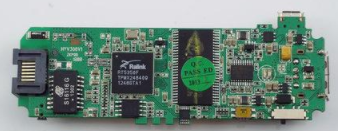About SMT processing surface assembly process inspection method
Common inspection methods in the surface assembly process mainly include manual visual inspection, non-contact inspection and contact inspection. Visual inspection mainly uses magnifying glass, binocular microscope, three-dimensional rotating microscope, projector, etc.; non-contact inspection mainly uses automatic optical inspection (Automatic OptICal Inspection, AOI), automatic X-ray inspection (Automatic X-Ray Inspection, AXI) ; Contact testing mainly uses in-circuit test (In Circuit Test, ICT), flying probe test (Flying Probe Test.FPT), functional test (Functional Test, FT), etc. Due to the different content and characteristics of each process, the detection methods used in each process are also different. Among the above inspection methods, manual visual inspection, automatic optical inspection and X-ray inspection are the three most commonly used methods in surface assembly process inspection.
1) Manual visual inspection method
This method requires little investment and does not require test program development, but it is slow and subjective, and needs to visually observe the tested area. Due to the lack of visual inspection, it is rarely used as the main welding quality inspection method on the current SMT production line, and most of it is used for repair and rework. With the miniaturization, fine-pitch and assembly density of components, direct visual inspection is becoming more and more difficult or even impossible. For example, the current 0201.01005, it is impossible to judge the welding quality with the naked eye. Therefore, most of them need a variety of optical magnifiers and special optical instruments. Typical examples include the VPI of Microscope.OK from the German company ERSA and related products from companies such as Christie in the United States. With the help of these products, on the one hand, not only can the inspection of conventional SMT solder joints be completed, but also the detection of hidden solder joints of BGA and other area array devices can be observed to a certain extent, which cannot be completed by direct visual inspection; on the other hand,, It is equipped with measurement function and even video function, so that it can be promoted and applied in process research and development and defect diagnosis.

2) Automatic optical inspection method
With the reduction of component package size and the increase of circuit board patch density, SMA inspection becomes more and more difficult, and manual visual inspection appears to be inadequate. Its stability and reliability are difficult to meet the needs of production and quality control. The use of automatic detection is becoming more and more important. Using automatic optical inspection (AOI) as a tool to reduce defects can be used to find and eliminate errors early in the assembly process to achieve good process control. AOI adopts an advanced vision system, a new light-giving method, a high magnification and a complex processing method, so as to obtain a high defect capture rate at a high test speed. The AOI system can inspect most of the components, including rectangular chip components, cylindrical components, button electrolytic capacitors, transistors, PLCC, QFP, etc. It can detect missing components, wrong polarity, mounting solder offset, excessive or insufficient solder, solder joint bridging, etc., but it cannot detect circuit errors. At the same time, it can do nothing to detect invisible solder joints.
(1) The position of AOI on the SMT production line. There are usually three types of AOI equipment on the PCBA production line.
1. The AOI used to detect solder paste failure after screen printing is called AOI after screen printing.
2. The AOI that is placed after the placement to detect the failure of the device placement is called post-attachment A0Io
3. The AOI that is used to detect device mounting and soldering faults after reflow soldering is called A0Io after reflow soldering is an example of defect detection after reflow soldering using AOI.
(2) AOI inspection process. AOI detection is one of the most commonly used detection methods in SMT.
1. Production preparation includes machine preparation, printed circuit board preparation to be inspected, file preparation, importing Gerber files, etc.
2. Parameter setting includes programming the standard board, you can use the component library or custom, frame the component with the custom frame, enter the type of component, set the threshold, upper limit, lower limit and other information.
3. Contour extraction includes automatic acquisition of printed solder paste, patch, and solder joint images by controlling the light source and other A0I; application of image processing algorithms for corresponding image processing; obtaining contour information of printed solder paste, components, and solder joints.